Black/African Americans in Fort Collins: Brochure Companion#
This is the virtual companion for the City's Black History walking tour. Before starting the tour, we encourage you to get to know more about Black History and community in Fort Collins on our main page for this content, HERE.
Download the Brochure
This page is a companion to the walking/biking tour brochure about Black/African American history in Fort Collins. Please feel free to download and/or print the brochure at the link below and follow along on your mobile device.
We encourage you to explore these sites on your own time, by car, bike, or on foot. Please share the street and be respectful to the privacy of the owners and residents of the homes on this tour by viewing them from the street/sidewalk only.
Disclaimer: The information about sites below relies on primary source material from Fort Collins history that often used racist and offensive terms to refer to Black Americans residing in the city. In some cases, those terms have been included here to acknowledge and accurately reflect on the experiences of Black Americans in Fort Collins and the challenges they faced, and sometimes still face, while living here.
Black Sugar Factory Community (demolished)#
Although its exact location is not currently confirmed, there was once a small neighborhood of Black residences northeast of Old Town between Jefferson Street and the Great Western Sugar factory on East Vine Drive. A 1903 newspaper account derisively referred to the area as “Coon Town,” which lay just outside Fort Collins town limits, “coon” being a common derogatory term for African Americans in the United States at the time. Not much is known about this community and the people who lived here. Our lack of knowledge about this community, where it was, what it looked like, who lived there, and for how long, is typical of communities around the United States. Black Americans were often segregated into underserved areas of communities and denied access to public services, education, housing, or employment opportunities. In many cases like Fort Collins, places associated with Black history have been lost with little or no documentation. While the location of this neighborhood is unknown, we encourage you to think about the experiences its residents would have had navigating the complexities of American life during the Jim Crow era in Fort Collins, which included both economic opportunities for Black residents but also widespread racism and discrimination.
1 - Avery Block, 105-115 Linden St & 100-124 N. College Avenue#
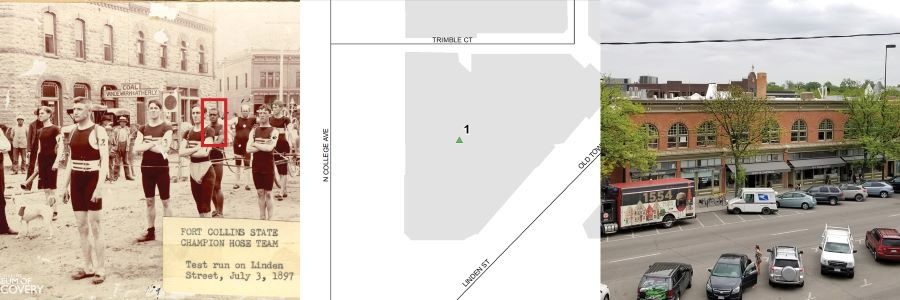
Left: Fort Collins Fire Department 1897 State Champion Hose Team, including William Clay (marked in red box). (H02779, Courtesy of the Fort Collins Museum of Discovery).
One of the most important things we can do when remembering and honoring Black history is to recognize that it is an integral part of the stories of our community – even though Black/African American history has often been absent from the greater American narrative. Places we already recognize as historic have connections to Black stories that must be acknowledged and told.
For example, the Avery Block has been at the center of much of Fort Collins’ commercial and social life since its construction between 1880 and 1897. Many of the city’s key professionals and business leaders had offices here, and it remains a commercial anchor for downtown Fort Collins. It also represents a common story for Black Americans seeking opportunity in the West – while jobs were available, racism and discrimination in employment meant that most Black residents could only secure service jobs even when they were trained and qualified for higher-paying positions. William Clay, the son of renowned Fort Collins resident Charles Clay, Sr., worked in the Avery building as a porter for the Ira O. McCarty dentistry in unit #26 from 1908 to about 1910, one of several service jobs he would have during his long life in Fort Collins. He also served with the Fort Collins Volunteer Fire Department based at the former firehouse on Walnut Street in the 1890s and was part of the department’s State Champion Hose Team in 1897. William’s is similar to many others of Black Fort Collins residents living and working in places that we acknowledge as historic, but have not previously recognized as connected to the stories of our city’s Black American residents. William Lyle worked as a janitor in the Poudre Valley Bank building at the south west corner of Mountain and College Avenues, a building determined eligible for City Landmark designation in 2019 for its Art Moderne architecture. Charles Birdwhistle, a local minister, worked as a headwaiter at the Northern Hotel on the southeast corner of Walnut Street and College Avenue, a City Landmark and a building listed in the National Register of Historic Places. Ella Mae Cook worked as a live-in servant for the Lear family at 1510 S. College, a City Landmark designated in 2007 for its distinctive Norman Cottage design.
2 - State Theater, 153 N. College Avenue (now 151 N. College Ave)#
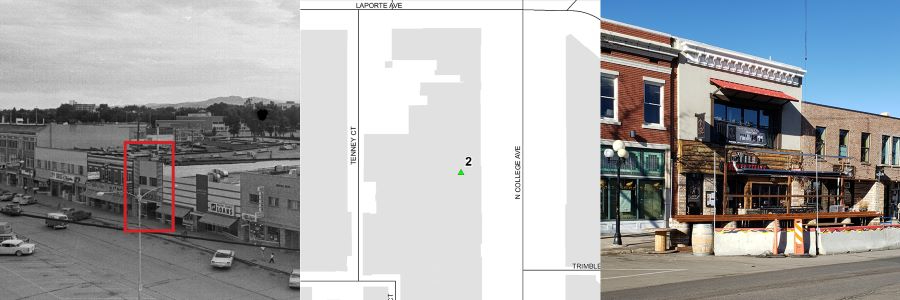
Left: The State Theater in 1967 after a remodel completed sometime after the Second World War. (C00018, Courtesy of the Fort Collins Museum of Discovery).
The building that still stands, now addressed as 151 N. College Avenue, has been many things over the course of its life since construction in the early-1900s. However, at one time in the 1930s-1940s, it was a movie hall that operated under several names, including the State Theater from 1938-1940. Historically, its design was simple, not unlike its current configuration, and it provided an entertainment alternative to the much more extravagant America Theater to the north at 163 N College (now addressed as 157 N College). It was also the site of a significant event in Black civil rights in Fort Collins. In March 1939, Mattie Lyle, an African American woman living at 312 N. Meldrum, sued L.C. Snyder, the owner of the State Theater, for discrimination. Ms. Lyle sued Mr. Snyder for discrimination in County court, won, and was awarded damages. Her testimony was supported by three witnesses: Mattie’s husband, William Lyle, her 13-year-old daughter, Joyce Lyle, and Stella Saunders, a friend who worked as a live-in servant.
3 - Thomas Residence (early), 308 Cherry Street#
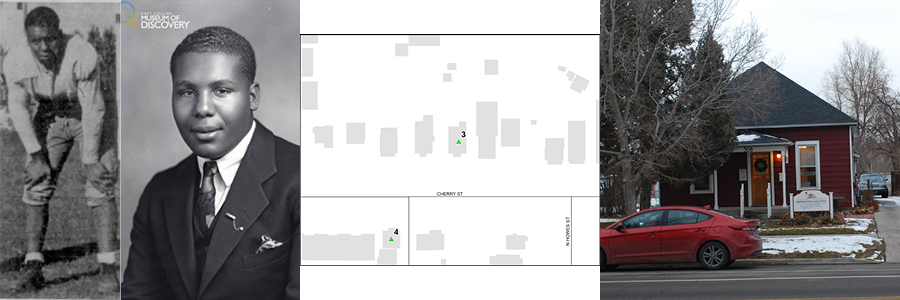
Far Left: Image from the Express-Courier of Virgil Thomas in his Fort Collins Lambkins uniform during his time playing at Fort Collins High School at Remington and Lake Streets in the 1930s. (Courtesy of the Fort Collins Coloradoan); Center left: Portrait of Virgil Thomas from the Mark Miller Portrait Collection (M07809, Courtesy of the Fort Collins Museum of Discovery)
John and Mamie Thomas resided at this property from approximately 1933 to 1938 with their son Virgil. John Thomas was born in 1885 in Missouri and married Mamie (Earley) of Virginia in St. Louis on August 4, 1907. The couple moved to Eaton in 1910 where their son Virgil was born. In about 1930 they moved to Fort Collins where Mamie worked as a cook for the school district and Virgil attended junior high and high schools. During Virgil’s time at Fort Collins High School in the late-1930s, he was a star left tackle on the Lambkins football team--the only Black player on the team and one of the few Black students in the school district. The Express-Courier covered his football career with the Lambkins closely, describing him as one of the best players on the team and a crucial part of the offensive line, partially because he was one of the largest players on the team at 200 pounds. In his free time, he was also a boxer and the starting pitcher for the Fort Collins softball club, the Reserves, where he became an essential player until he left town in 1941. Around 1940, the family moved down the street to 316 Cherry, a home they would later purchase. Virgil left Fort Collins in 1941 to attend Wilberforce College in Ohio on a football scholarship and served as an infantry corporal during World War II in Italy and Germany. John and Mamie remained in their home at 316 Cherry until sometime after 1968 when John passed away.
4 - McDaniel Residence, 317 Cherry Street#
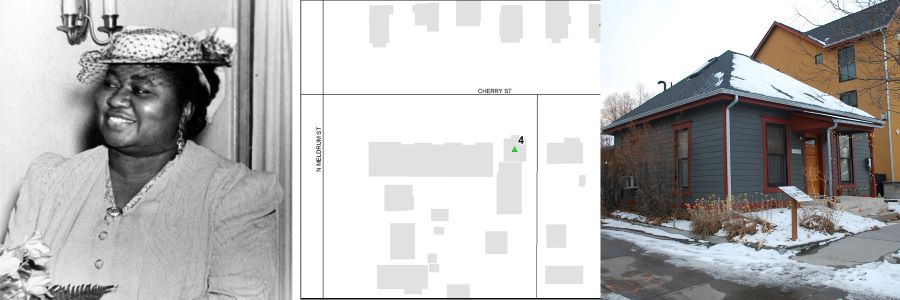
Left: Hattie McDaniel after rising to prominence in Hollywood as a film star. (Scurlock Studio Records, Archives Center, National Museum of American History, Smithsonian Institution).
Although they only lived in Fort Collins for a short time, the McDaniels are the most well-known Black family in early Fort Collins history. Henry and Susan McDaniel, both enslaved at birth, were among the early wave of “Exoduster” Black migrants who moved from the Jim Crow South to Kansas to seek greater freedom and opportunities in the 1870s. The McDaniels later moved from Wichita to Denver, and for a brief time in the early 1900s lived in Fort Collins at 317 Cherry Street. Henry worked locally as a teamster, as well as an itinerant Baptist preacher. Both Henry and Susan were gospel singers and several of their children grew up to be talented performers. While they lived on Cherry Street, their young daughter, Hattie McDaniel, attended the Franklin School at Howes & Mountain. Hattie later rose to fame as a radio performer on Denver’s KOA station before moving on to pursue work in vaudeville and eventually a successful Hollywood film career. She is most remembered for being the first Black American to win an Academy Award for her 1939 role in Gone with the Wind. Hattie is also recognized for her civil rights activism as a participant in the groundbreaking 1945 “Sugar Hill” lawsuit that ended restrictive racial covenants in her Los Angeles neighborhood. Although sometimes criticized for playing stereotypes of African Americans in her film roles, she is credited with paving the way for Black Americans in Hollywood.
5 - Hicks/Lyle Residences, 310 & 312 North Meldrum Street#
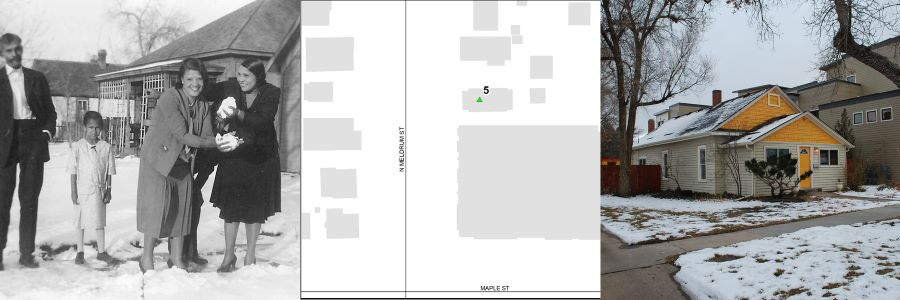
Left: Mattie Lyle, far right; William Lyle, crouching behind, second from right; unidentified woman, center; Joyce Lyle, second from left; unidentified man, far left; circa early 1930s. Photo courtesy of the Starr & Lyle Family, www.starrlyle.com. Right: 312 N. Meldrum, the surviving residence of the pair.
The residence at 312 N. Meldrum, and one that used to sit next door at 310 N. Meldrum, were the residences of two long-standing Black families that resided at both addresses during their time in Fort Collins. Harkless and Hattie Hicks were a young Black couple from Kentucky who were living in Fort Collins by 1900. Harkless and Hattie and their two children lived at 310 N. Meldrum while Harkless worked as a janitor and Hattie as a laundress. After Hattie died in 1906, Harkless married a woman named Josie. The couple remained at this property for a while but had moved next door to 312 N. Meldrum by about 1919. In 1925, they gained new neighbors at 310 N. Meldrum, William and Mattie Lyle, a young couple from Kansas. William and Mattie were well-educated and met at the Kansas State Normal School (now Emporia State University), but nonetheless both worked as janitors while they lived in Fort Collins. After Josie died, William Lyle’s mother, Martha Lyle, moved in with Harkless and worked as his housekeeper. When Harkless died in 1932, the Lyles family (William, Mattie, and daughter Joyce) moved into the property at 312 N. Meldrum.
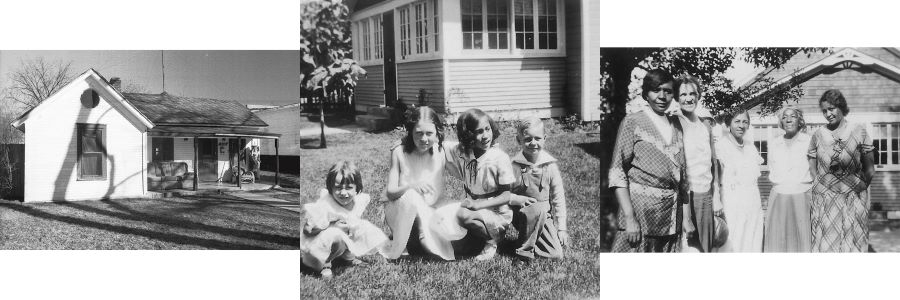
Left: 310 N. Meldrum St, 1995 prior to being demolished. (H15765, Courtesy of the Fort Collins Museum of Discovery); Center: Joyce Lyle, second from right, with unidentified friends, c1930s. Photo by Mattie Lyle, (Courtesy of the Starr & Lyle Family, www.starrlyle.com); Right: Martha Lyle, center, with unidentified friends or neighbors in front of 312 N Meldrum, circa 1935. (Photo courtesy of the Starr & Lyle Family, www.starrlyle.com).
In 1939, while they lived here, Mattie visited the newly opened State Theater at 153 N. College Avenue with her family and was not provided full access to the facility. With supporting testimony from her husband, daughter, and a friend, she successful sued the theater owner, L.C. Snyder, for discrimination and a jury awarded her damages. Mattie’s decision to pursue justice through the legal system is notable in light of her family history: her great-great uncle was Bird Gee, who took a discrimination case against a Kansas hotel to the United States Supreme Court as one of the notorious five civil rights cases of 1883. In those cases, the Court chose to nullify the 1875 Civil Rights Act and facilitated another century of legalized discrimination. She was also a cousin to Loren Miller, the well-known civil rights attorney who represented Hattie McDaniel and others in the 1945 “Sugar Hill” restrictive covenants lawsuit. Miller then served as chief counsel before the Supreme Court in the 1948 Shelley v. Kraemer decision that led to the outlawing of racial restrictive covenants nationwide. The case had local ramifications for the new Fort Collins subdivisions of Slade Acres and Circle Drive, which included racial covenants. But by the time these events took place in 1948, the Lyles were no longer residents of Fort Collins. They had left for Seattle, where they made their home for the rest of their lives.
6 - Clay Residences and the Mission, 317 & 321 Maple St. (demolished)#
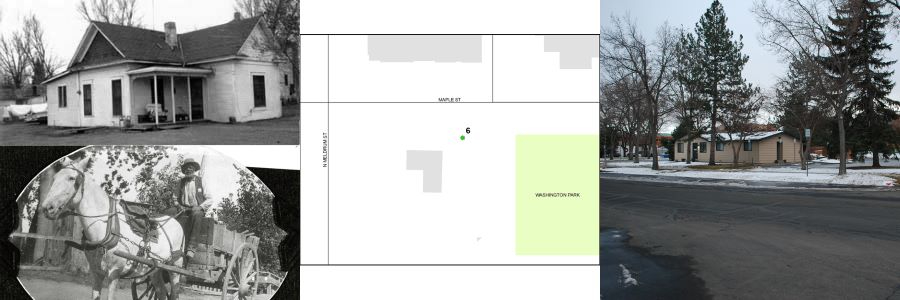
Top Left: 321 Maple Street, 1969, prior to demolition in the early 1970s (321Map69); Bottom Left: Charley Clay, c.1880s (M14771) (Both images Courtesy of the Fort Collins Museum of Discovery)
The Clay family was the most prominent, long-standing Black family in early Fort Collins history. Charley Clay arrived in Colorado in 1864 as a cook accompanying a military detachment sent to the Overland stage station at Fort Latham. He arrived in Laporte the following year, where he found work as a barber and cook. Although not appearing in the 1880 census, Clay was well-known in the Fort Collins area by 1882 as a caterer and cook. Charles and his wife, Anna, had seven children. The Clay home was the center of Black social life in Larimer County during the early 1900s. Out of his home at 317 Maple Street, Charley Clay ran the Colored Mission, which became the Zion Baptist Church, and ministered to Black families throughout the region. His son, Charles Clay, Jr., established a home next door at 321 Maple. The Clays hosted visitors and entertainers and meetings and important social gatherings, such as the local chapter of the Paul Laurence Dunbar Literary Society, a national organization named for the famous Black poet that discussed current social and political issues. In his later years, Charley, Sr. worked for the city as the “scavenger,” removing disposed items and trash that accumulated on public streets due to lack of waste removal services. Most of the large Clay family had dispersed to other communities or had passed away by the time the family patriarch was laid to rest in Grandview Cemetery in 1910. Charles Jr.’s wife, Nellie Clay, was the last family member on record at 321 Maple. She lived in the home in 1919 while working as a janitor at the Empress and Lyric Theaters, but by 1920, she had moved. The properties were torn down in the early 1970s to make way for the new City Hall complex, including the building present today, constructed as a computer center.
7 - Andrew and Edith Goodall Residence, 131 N. Mack Street#
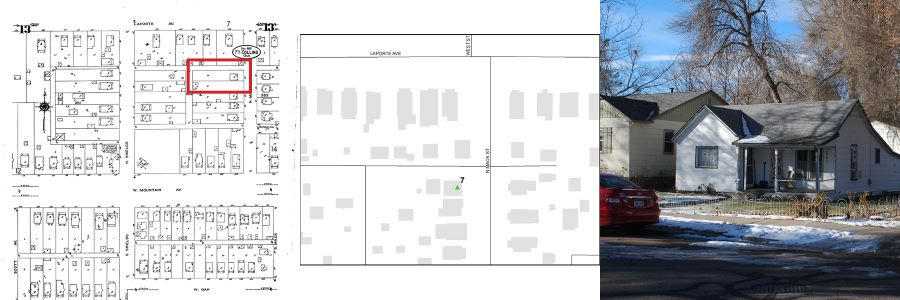
Left: 1925 Sanborn Fire Insurance Map of the neighborhood, showing the property in the red box. (Sanborn Fire Insurance Maps, accessed through the Poudre Libraries District).
By 1909, Andrew and Edith Goodall, and their son James moved into this home at 131 [North] Mack Street. Edith Goodall became active in the Woman’s Christian Temperance Union (WCTU) and hosted an integrated meeting of the organization in their parlor. The WCTU was a national women’s rights and anti-liquor organization established in the late-1800s. The Fort Collins chapter was best known for successfully promoting the women’s suffrage referendum in 1893 that successfully granted Colorado white and Black women the vote. The organization, including the local chapter, continued their work to support national suffrage via the Nineteenth Amendment, ratified in 1920, and through work to promote temperance against alcohol in Fort Collins. Edith was also a missionary, active in trying to establish a branch of the African Methodist Episcopal Church in Fort Collins and it seems likely she would have collaborated with the Clays, Lyles, and Birdwhistles in that goal. The Goodalls were early investors in the Black agricultural colony of Dearfield in Weld County, east of Greeley. After they relocated there sometime after 1913, they maintained social ties in Fort Collins. The remains of Dearfield remain and were recognized recently by Colorado Preservation, Inc. as an Endangered Place.
8 - Charles & Mamie Birdwhistle Residence, 1005 W Oak St#
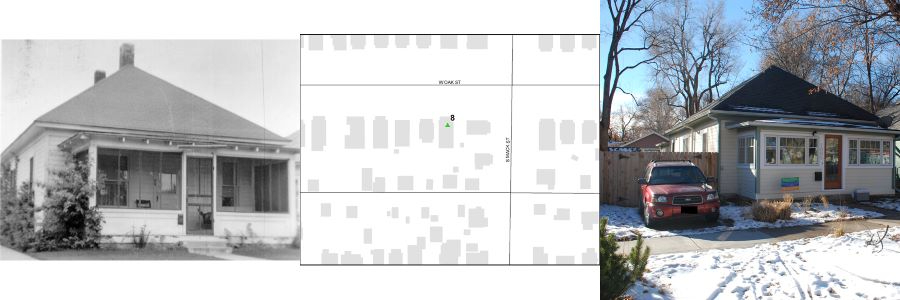
Left: 1005 W. Oak Street in 1948. (1005WOak48, County Assessor photos, Courtesy of the Fort Collins Museum of Discovery).
Charles Birdwhistle grew up in a well-established Black community in Topeka and moved to Colorado along with a wave of Black Americans in the Great Migration that began after World War I. Birdwhistle, a well-educated Spanish-American War veteran and a gifted orator, vaudeville performer, preacher, and community leader, was nonetheless limited to job opportunities in service positions in Fort Collins, which included headwaiter at the Northern Hotel and janitor at the YMCA and the City’s Light and Power department. These positions ensured that he was well-known to many in the Fort Collins community.
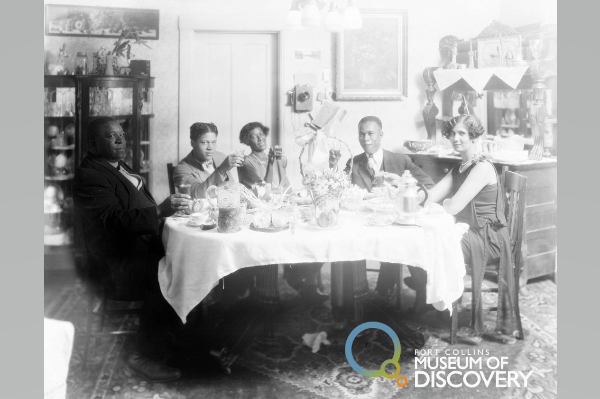
The Birdwhistles entertaining guests in their home at 1005 W. Oak Street, c.1920s. (M00350, Courtesy of the Fort Collins Museum of Discovery)
Birdwhistle and his wife, Mamie Lowe Birdwhistle, owned their home on Oak Street, where they were the only Black residents on the block. It was the location for many gatherings of the Black community from 1920 to 1946. When Black gospel groups and jazz orchestras came to Northern Colorado to perform, or the college hosted Black scholars, the Birdwhistle home served as an informal hotel and refuge. While Denver had several hotels that catered to African Americans in Five Points, Black travelers in Northern Colorado who wished to stay overnight were forced to rely on accommodations listed in the Negro Motorist Green Book (Greeley had two), or the hospitality of friends, family, and Black community members such as the Birdwhistles.
In addition to playing host to travelers, Birdwhistle served as a pastor in the African Methodist Episcopal Church in Colorado, which required him to travel around the state to visit the communities he served. He turned down opportunities to take permanent positions as a pastor in other cities because he was committed to serving Fort Collins. Despite his resolve, efforts to secure a permanent location for the church in Fort Collins were not successful. Charles Birdwhistle died suddenly of a stroke on Pine Street in 1946 and was buried in Topeka, Kansas, where much of his family remained.
9 - President William Morgan Residence, 645 S. Shields St.#
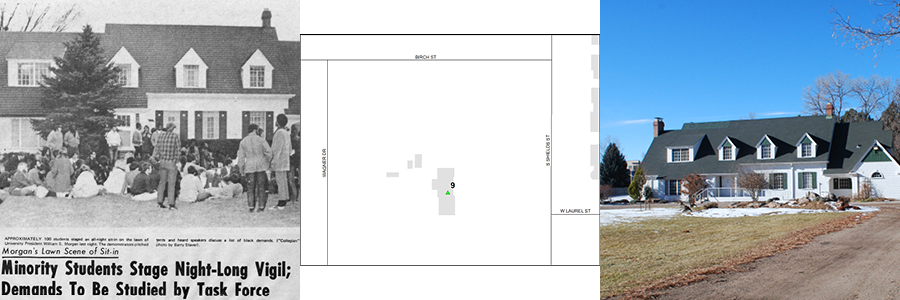
Left: The student-led protest by the Black Student Alliance and Mexican American Committee for Equality (MACE) on the front lawn of Morgan's private residence, April 10, 1969. (Courtesy of the Rocky Mountain Collegian).
In April of 1969, following the anniversary of the assassination of Dr. Martin Luther King the year prior, the Black Student Alliance (BSA) and the Mexican-American Committee for Equality (MACE) presented joint demands to address the lack of diversity on campus to the CSU administration, followed by an occupation on April 9 of the Administrative Building and a non-violent protest in front of President William E. Morgan’s residence. Here at the Morgan residence, Black and Chicano/a students held a peaceful, all-night sit-in on the front lawn to draw attention to their cause. Of key concern was a distinct lack of recruitment of people of color as students or employees at the University, but also central to the cause was off-campus housing discrimination by landlords. The result was the formation of a special minority task force to guide a recruitment effort focusing on Black, Chicano, and Indian students, which did not proceed because the Colorado General Assembly and the CSU student body failed to support funding for the effort. This moment, and many other protests between 1969 and 1970, drove attempts at reform regarding issues of race and racism at CSU, some of which met with success.
10 - Moby Arena, 951 W. Plum Street#
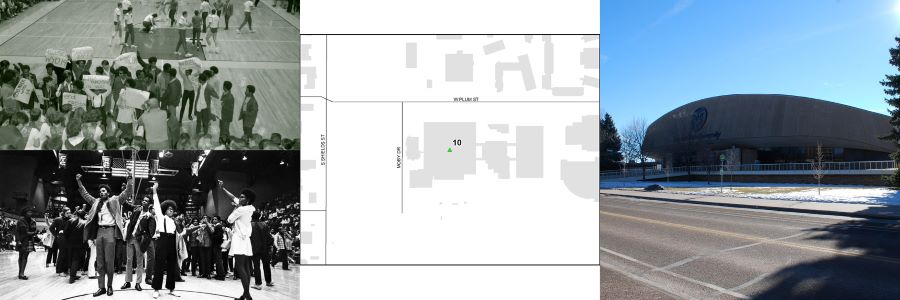
Left: Black Student Alliance members protesting at the 1970 BYU-CSU Men's Basketball game on February 5. (Alumni Photograph Collection, Colorado State University Libraries, Archives & Special Collections).
At a CSU-BYU basketball game on February 5, 1970, African-American, Latinx, and white CSU students staged a sanctioned, non-violent, pre-game protest against the Mormon Church’s ban on allowing Black men to serve in the priesthood. Similar demonstrations and actions were taking place on other campuses when the all-white BYU team arrived to play. Many participants in the protest also held signs to “Remember the Wyoming 14,” the fourteen Black football players on the University of Wyoming team that were abruptly dismissed by head coach Lloyd Eaton for requesting to wear black armbands in protest during the UW-BYU matchup scheduled for 1969. Organizers of the Moby protest were also calling attention to racial discrimination in Fort Collins, particularly the ongoing struggle to address housing discrimination from rental agencies and landlords who would not lease to Black renters. At halftime, students took the court to continue the demonstration. While the protestors were leaving the court, police officers in riot gear arrived, the crowd began throwing things, a journalist received a head injury, fighting broke out, and some students were arrested. The event remains an important milestone in the struggle to create a more just and welcoming campus and community for all races and ethnicities.
11 - Lory Student Center, 1101 Center Avenue Mall#
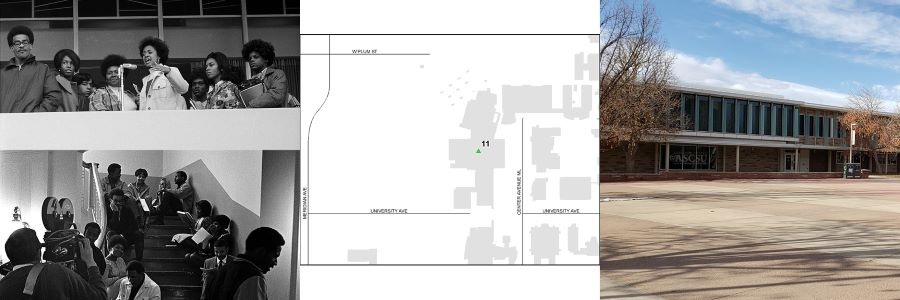
Top left: Black Student Alliance (BSA) members speaking during a minority student recruitment demonstration, April 16, 1969; Bottom left: BSA students at a sit-in at the Old Main administration building on April 10, 1969. Old Main was burned down in 1970. (Both images courtesy of the Student Life & Activities Collection, Colorado State University Libraries, Archives & Special Collections).
CSU’s Lory Student Center (LSC) has been the heart of student activities on campus since it opened in 1962. It has served as the home to student organizations as well as a site of student protests and other major events, such as national civil rights leader James Meredith’s speech in 1963. Meredith’s 1962 admission to the University of Mississippi as its first Black student was a pivotal moment in the history of civil rights in the United States. Meredith, who endured severe harassment as a student while he completed his degree, called on the CSU audience of 1,400 people to accept their personal responsibility in the country’s “number one internal problem, which will never be solved without action by all Americans, not just special groups in the South.”
The LSC has also been associated with the annual commemoration of the life and service of the Reverend Martin Luther King since the Black Student Alliance sponsored the first memorial gathering and demonstration in Dr. King’s honor on April 4, 1969, one year after his assassination. A few days following the demonstration by more than 100 students in the LSC plaza, students presented another list of demands to CSU President William E. Morgan. The State and the University failed to make meaningful progress on the recruitment issues, in part because authorities failed to authorize funding for the effort. However, the work of the BSA and MACE ultimately led to the creation of both the Black/African American Cultural Center, El Centro (the Latinx student services office), and an ethnic studies program in the College of Liberal Arts meant to improve education about non-white culture. While respect, inclusion, and diversity continue to be acknowledged in Fort Collins and at CSU, the work of these student protesters provided a path forward that is still recognized and being built today.
Other Sites#
Check out these other sites related to early Black history in other parts of Fort Collins.
Fort Collins High School (c.1925) & Virgil Thomas#
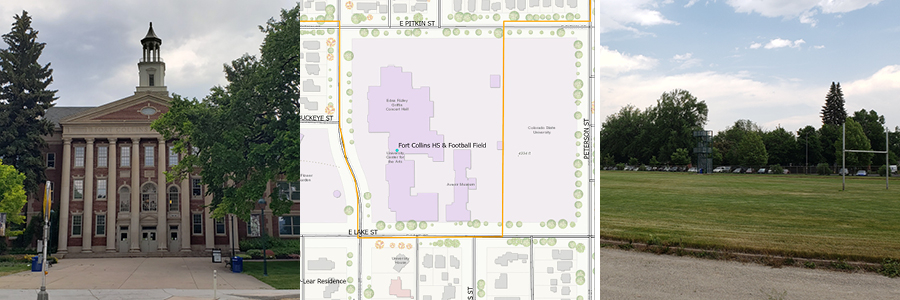
Left: The former Fort Collins High School on Remington Street; Right: Fort Collins High School football field looking northeast toward Peterson Street.
As noted above at site #3, Virgil Thomas is believe to be the first Black/African American graduate of Fort Collins High School in the class of 1940. While attending classes here between 1937 and 1940, Virgil also boxed for the high school club and played football for the Lambkins varsity team. He was celebrated by the Fort Collins Express-Courier as a key player in the Lambkins' offensive line at the time. The High School is now the University Center for the Arts for Colorado State University, and has been adaptively reused as office, museum, and performing arts space for the University's fine arts programs. The football field now serves as the practice field for the CSU Marching Band.
1510 S. College - Bradley-Lear Residence & Ella Mae Cook#
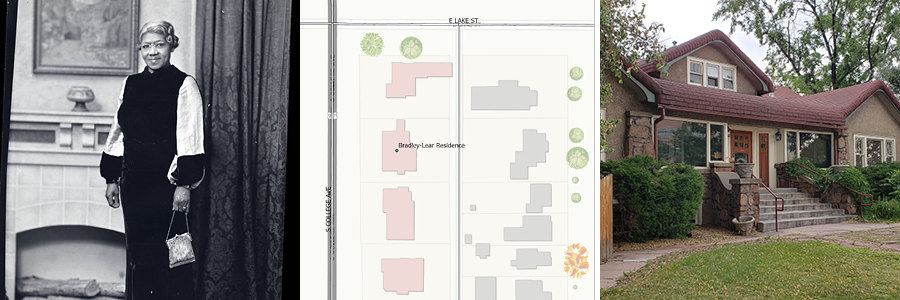
Left: Ella Mae Cook in a personal portrait (Miller Collection, Courtesy of the Fort Collins Museum of Discovery); Right: Bradley-Lear Residence at 1510 S. College Avenue, where Ella Mae worked during the early 1940s.
Among the important aspects of Black history to understand is the invisibility of Black labor in places we already recognize as important. Buildings like the Avery Block at Linden Street and Mountain Avenue, and the City Hall & Fire Station on Walnut Street, remind us that many spaces we recognize for other reasons represent Black experiences in our community as well. Those experiences are often ignored or disconnected from these spaces. For example, this house, the Bradley Residence, was Landmarked in 2007 by the City of Fort Collins for its architectural significance as an example of English Norman Cottage design. However, during the 1940s when the Lear family lived here, they also employed a live-in domestic worker, Ella Mae Cook. Ella Mae was a Black woman born in Eskridge, Kansas in 1887. She married a Benjamin Davis in Alva, Kansas in in 1906, but he passed away many years later and Ella Mae moved to Fort Collins. Here she began working for the Lear family - she was one of a small number of Black domestic workers in Fort Collins for wealthier families. Black women often found domestic work one of the only avenues to earn a living in American communities due to widespread employment discrimination. In 1941, Ella Mae married Alonzo Boykin and they moved to an apartment at 1325 S. College Avenue that year. She passed away in 1944 and her remains were sent to Denver for burial.